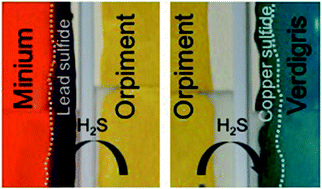The darkening of copper- or lead-based pigments explained by a structural modification of natural orpiment: a spectroscopic and electrochemical study
Abstract
A combined Raman and electrochemical study of natural orpiment (As2S3), an arsenic sulfide pigment, was used to assess the quick formation of oxidized species such as arsenic oxide (As2O3) upon exposing the pigment to 405 nm or 532 nm monochromatic light while simultaneously recording the Raman spectra of the exposed sample. During this process, a distortion of the main band at 355 cm−1, associated with the stretching of the AsS3/2 pyramids of natural orpiment, was observed as well as an increased intensity of the 359 cm−1 band, corresponding to covalent As–As bonds in natural orpiment. The distortion was accompanied by an overall decrease of the global Raman signal for natural orpiment, which could be explained by a loss in the crystal structure. The same phenomena were recorded in reference natural orpiment model paint samples stored for a long time together with verdigris (Cu(OH)2·(CH3COO)2·5H2O) and minium (Pb3O4) paints, the latter two appearing darkened on their sides closest to the orpiment sample as well as in several historical samples containing natural orpiment mixed with various blue pigments. By SEM-EDX and XRPD analysis, respectively on loose material and cast thin-sections of model paint samples, the darkening was identified as dark sulfide species such as chalcocite (Cu2S) and galena (PbS), suggesting the release of volatile sulfide or related species by the natural orpiment paint. XANES analyses of paint samples presenting As–As bond increase indicated the presence of sulfur species most likely identified as organosulfur compounds formed upon the As–As bond formation and explained the darkening of the Cu- and Pb-based pigments. To the best of our knowledge, this article reports for the first time the light-induced formation of As–As bonds in natural orpiment used as an artists' pigment and objectively demonstrates the incompatibility between orpiment and (arsenic) sulfide-sensitive pigments.



 Please wait while we load your content...
Please wait while we load your content...